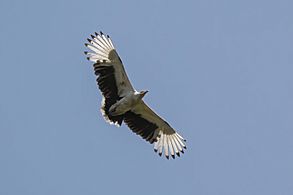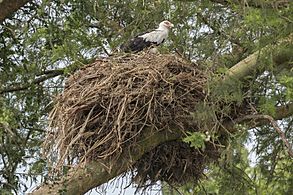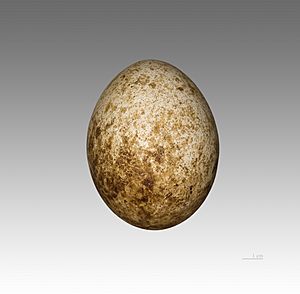Palm-nut vulture facts for kids
Quick facts for kids Palm-nut vulture |
|
|---|---|
 |
|
| Conservation status | |
| Scientific classification | |
| Kingdom: | |
| Class: | |
| Order: | |
| Family: | |
| Genus: |
Gypohierax
|
| Binomial name | |
| Gypohierax angolensis (Gmelin, 1788)
|
|
The palm-nut vulture (Gypohierax angolensis) is a bird found throughout most of Africa. It feeds mainly on the fruit of the oil palm. Like many African vultures, it is quite approachable and can be seen near habitation.
Contents
Description
This is a nearly unmistakable bird as an adult. At 1.3–1.7 kg (2.9–3.7 lb), 60 cm (24 in) long and 150 cm (59 in) across the wings, this is the smallest Old World vulture. Its plumage is all white except for black areas in its wings and tail. It has a red patch around each eye. The juvenile, which takes 3–4 years to mature, is brown with yellow eye-patches.
In flight, this species resembles an eagle more than a typical vulture, and it can sustain flapping flight, so it does not depend on thermals. With its extensive white plumage, and black wing- and tail-feathers, the adult palm-nut vulture can be crudely mistaken for both the African fish-eagle and the Egyptian vulture, but clearly lacks the chestnut body of the former and the white tail of the latter.
The sexes are almost identical in appearance, with the female being only slightly larger than the male. Juveniles on the other hand are predominately brown with partially black wings and take a lengthy three to four years to make the transition into the adult plumage
Distribution and density
Palm-nut vultures are found throughout most of the coastal areas of the African continent from The Gambia to Kenya and as far South as South Africa. The total African population is estimated to be 80 000 pairs. There are approximately 40 birds in South Africa.
Habitat
As the name suggests, the distribution of the palm-nut vulture closely tracks that of oil (Elaeis sp.) or raffia (Raphia sp.) palms. Consequently, it is most common in coastal forests and mangrove swamps below 1,500 metres, but also occurs in wet savannas.
Diet and feeding habits
Unusual for birds of prey, it feeds mainly on the fleshy fruit-husks of the oil-palm and on the palm-fruits of raphia (Raphia australis). These fruits make up over 60% of the adult bird's diet and over 90% of the juvenile bird's diet. It has also been recorded to feed on crabs (both freshwater and marine), molluscs, frogs, fish, locusts, small mammals, even reptiles’ eggs and hatchlings, and it has been known to occasionally attack domestic poultry and feed on carrion.
Nesting
Breeding pairs construct large stick nests high up in tall trees and will often exhibit a strong attachment to the nest site. They may stay at the nesting site for an entire year. Where Raphia Palms are present, breeding pairs will build a nest as the base of the palm fronds. At the beginning of the breeding season, pairs soar together in an aerial display of rolling and diving, much more acrobatic than most vultures. During each breeding cycle, a single, white and brown egg is laid, which is incubated by both sexes, over a period of four to six weeks. Normally around 85 to 90 days after hatching, the young brown chicks will fledge.
Palm-nut vultures in South Africa
The only Southern African subregions to have the breeding resident pairs of Palm-nut vulture is South Africa and Mozambique.The breeding distribution of the Palm-nut Vulture during the 1970s census period was centred on the Raffia Palm groves of the Kosi Bay system and Mtunzini. Its distribution is linked to the presence of Raffia Palms Raphia australis at all permanently occupied sites, and the existence of this species at Mtunzini is entirely due the artificial cultivation of Raffia Palms Currently there are 7 known nesting sites In South Africa and a total of 40 individual birds.
Images for kids
-
Immature bird in Selous Game Reserve, Tanzania
See also
 In Spanish: Buitre palmero para niños
In Spanish: Buitre palmero para niños








